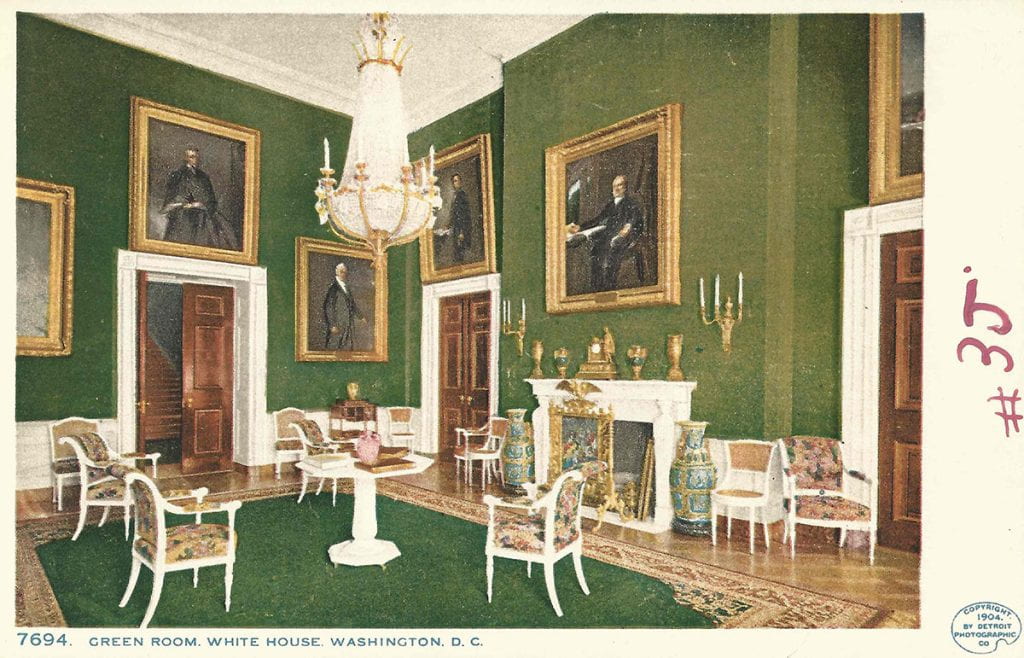By Katie Roxberry, M.A. ’24, Museum Studies
The Detroit Publishing Company produced a set of postcards in 1912 that showcased the White House’s State Dining Room, Red Room and Green Room. The postcards offered a glimpse inside the executive mansion for Americans unable to travel to Washington. What the images didn’t convey was how the rooms changed according to incoming presidents’ decorative tastes—a tradition that First Lady Jacqueline Kennedy changed when she moved in.

Before the Kennedy administration, presidential families imported, discarded and altered White House furniture and artifacts to suit their needs and desires. Thomas Jefferson used the Entrance Hall to display artifacts from the Lewis and Clark expedition. First Lady Mary Todd Lincoln exceeded Congress’s $20,000 refurbishment budget by almost $7,000 on new carpets, curtains and furniture. Throughout the years, the Resolute Desk, a gift to President Rutherford B. Hayes from Queen Victoria in 1880, was relocated from the second floor to the ground floor to a storage room. Jackie Kennedy, recognizing the desk was made from the wood of H.M.S. Resolute, had it moved to the Oval Office in support of her husband’s love of sailing. The desk has remained there ever since.
Jackie Kennedy believed the White House should be a place that honored and preserved its history. President Kennedy resisted her ideas, worried that the financial endeavors of buying and collecting historical artifacts would raise complaints from both Congress and the American public. Jackie Kennedy’s solution was to establish the Fine Arts Committee for the White House and the private, non-profit White House Historical Association.
The Fine Arts Committee, of which Jackie Kennedy was an honorary chairwoman, consisted of 11 additional members who collectively made acquisition decisions. The committee sought presidential objects and furniture from time periods that were not represented in the White House. An advisory committee of museum curators, directors and other prominent historical leaders guided the committee’s decisions. To raise funds for the acquisitions, the White House Historical Association developed and published a 132-page White House guide book. Copies sold for one dollar.
Concerned that future presidents would return to old habits of discarding important pieces, Jackie Kennedy pressured Congress to pass a law that treats portions of the White House ground floor as a museum and declares the artifacts as White House property. The law stipulates that the U.S. President may authorize White House objects to be loaned to the Smithsonian for conservation, care, storage, research and exhibition purposes.

Jackie Kennedy wanted to give the nation a glimpse of the White House’s historical restoration. The popularity of postcards with famous landmarks and buildings had significantly declined by the 1960s. In keeping with the presidential campaign notes of a “new frontier” and “new beginnings,” Jackie Kennedy chose a more modern approach to connect the American public with the president’s house: a televised tour. In 1962 she coordinated and hosted “A Tour of the White House with Mrs. John F. Kennedy.” Over 86 million viewers tuned in to CBS and NBC to watch as the First Lady guided her co-host, CBS correspondent Charles Collingwood, through the White House, explaining the historical significance of certain acquisitions. She earned a special Emmy Award for the documentary.
Without laws regulating White House residents’ actions, presidents and their families before the 1960s constantly made structural and interior changes. The furnishings and style of the rooms captured in the 1912 postcards changed alongside the technology and platforms used to connect Americans with the White House. First Lady Kennedy took important steps to preserve and maintain the historical accuracy of the White House while embracing modern technology that allowed behind-the-scenes access.
Read more about Jackie Kennedy’s preservation work in Washington:
Jackie Kennedy’s Washington
Jackie Kennedy and Lafayette Square
Jackie Kennedy and the Kennedy center
About the Author
Katie Roxberry has a B.A. in history and English and is currently pursuing a master’s degree in museum studies at GW. She enjoys researching and writing on historical objects while working as the digital media editor for the Albert H. Small Center for National Capital Area Studies.
Header image: Postcard of the Red Room, White House, produced by Detroit Publishing Co., 1912. Albert H. Small Washingtoniana Collection AS 964 (A – 38).
